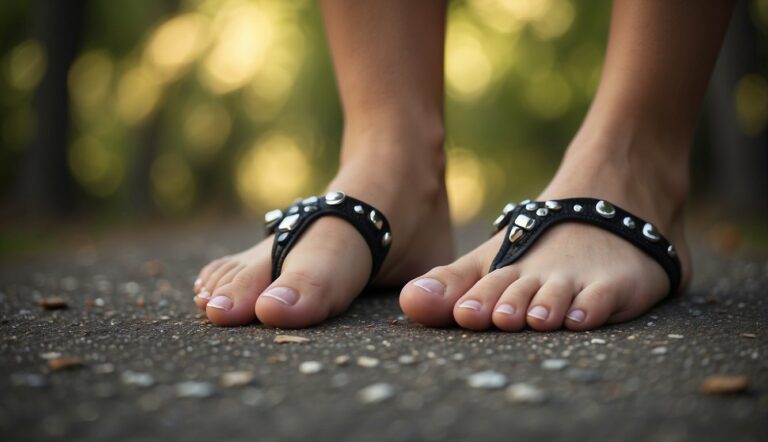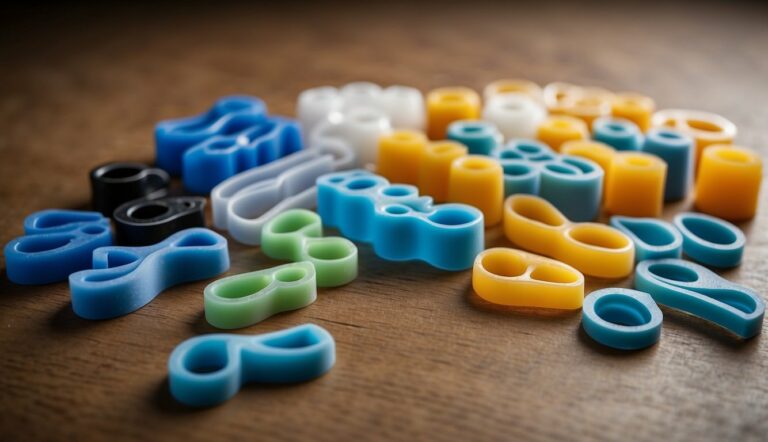Are Toe Spacers a Temporary or Permanent Solution? A Critical Look
As someone with a keen interest in foot health and a wealth of personal experience with toe spacers, I’ve witnessed their benefits first-hand. Toe spacers, the small devices inserted between toes, aim to alleviate pain and rectify problems associated with toe misalignment, such as bunions and hammertoes. Many individuals use them for both immediate comfort and as part of a broader strategy for improving the health of their feet.
From my experience, the intended effect of toe spacers is often a subject of inquiry. While they can offer significant relief from discomfort and aid in promoting proper toe alignment, they are generally considered a complementary measure rather than a standalone cure. As such, they are typically employed alongside other foot care practices, suggesting that their role is more supportive and preventive in nature.
Given that toes play a critical role in overall balance and body support, maintaining their health is essential. Toe spacers serve to address various toe-related ailments by temporarily repositioning the toes to a more natural state, helping to reduce the pressure and friction that might lead to corns, calluses, and other discomforts. Ultimately, their effectiveness is best measured in tandem with appropriate footwear choices and, if necessary, professional medical advice for persistent or severe conditions.
Are Toe Spacers a Temporary or Permanent Solution?
Toe spacers are generally considered a temporary solution for providing relief and promoting proper toe alignment. They can help alleviate pain, improve foot function, and potentially assist in correcting certain foot deformities when used consistently over time.
However, they typically do not provide a permanent correction, especially for structural issues, without additional interventions.
Here’s a more detailed look at their role:
- Temporary Relief: Toe spacers can offer immediate, temporary relief from discomfort caused by toe crowding, overlapping toes, or conditions like bunions and hammertoes.
- Long-Term Use: With long-term and consistent use, toe spacers may contribute to lasting improvements in toe alignment and foot function, but they usually need to be used continuously to maintain these benefits.
- Complementary to Other Treatments: For more permanent solutions, toe spacers are often used in conjunction with other treatments such as physical therapy, strengthening exercises, and changes in footwear. In some cases, surgical intervention may be necessary for permanent correction of certain conditions.
It’s important to consult with a healthcare professional for a personalized assessment and to determine the most effective use of toe spacers as part of an overall treatment plan for foot health.
Common Toe Spacer Use Case
Toe deformities can impact balance and lead to foot pain, while spacers aim to alleviate discomfort by realigning the toes. Understanding how toe deformities develop and how toe spacers function is crucial for individuals seeking relief.
Causes of Toe Deformities
Toe deformities like bunions, hammertoes, and toe crowding occur due to various factors such as genetics, unsuitable footwear, or underlying conditions like flat feet. Bunions form when the big toe shifts inward, creating a bony protrusion, while hammertoes are characterized by an abnormal bend in the toe joints.
- Bunions: Often hereditary; exacerbated by tight or pointed shoes.
- Hammertoes: Due to muscle imbalance; can be aggravated by shoes with narrow toe boxes.
- Corns/Calluses: Develop from continuous toe rubbing; tight shoes play a role.
Role of Toe Spacers
Toe spacers serve as an intervention to help reposition the toes into a more natural alignment, providing relief from the pressure and discomfort caused by toe deformities. They are not a cure, but they can offer temporary ease for symptoms associated with misalignments.
- Recovery: Assist in the recovery process after surgery or injury.
- Pain Relief: Offer temporary respite by alleviating pressure.
- Preventive Measure: Help prevent worsening of deformities when used consistently.
Types and Materials of Toe Spacers
Toe spacers and separators come in various shapes, sizes, and materials, like silicone, gel, or foam, to cater to different needs and preferences. Their design fits between the toes to gently push them apart.
- Silicone/Gel: Offers flexibility and comfort; suitable for daily wear.
- Foam: Typically for short-term use due to less durability compared to gel or silicone.
- Sizes: Availability in different sizes is essential to fit diverse foot shapes.
| Materials | Properties | Usage |
|---|---|---|
| Silicone | Durable, flexible | Long-term, everyday use |
| Gel | Soft, moldable | Comfort for sensitive skin |
| Foam | Lightweight, less durable | Short-term relief or specific activities |
I choose materials that cater to comfort and recovery needs, ensuring they can be paired with shoes for daily activities. It’s important to select the right size and material for both effectiveness and comfort.
Application and Effectiveness of Toe Spacers
Toe spacers are designed to relieve pain and improve the alignment of the toes through consistent use. They are typically crafted from materials like silicone or gel for added comfort and flexibility. Here, we’ll explore their application and effectiveness in addressing toe discomfort and alignment issues.
How to Use Toe Spacers
To use toe spacers effectively, insert them between your toes, making sure they fit snugly but not so tightly that they cause discomfort. They can be used during various activities, such as while relaxing, during yoga, or even when receiving a pedicure. Consistency is key—daily use can lead to better results. Regular stretches and exercises to strengthen the foot may complement the use of toe spacers for improved foot strength and stability.
Quick Guide to Wearing Toe Spacers:
- Ensure toes are clean and dry.
- Insert spacers gently between each toe.
- Begin with shorter periods of wear, gradually increasing as comfort allows.
- Use during low-impact activities for added benefits.
Expected Outcomes and Efficacy
The primary goal of toe spacers is to realign toes and alleviate pain, potentially improving overall foot comfort. Users often feel immediate relief during use, although toe spacers are not a permanent fix for structural toe issues. A podiatrist may recommend toe spacers as part of a broader treatment plan for optimal long-term foot health.
Typical Results from Toe Spacers:
- Temporary pain relief and increased comfort.
- Enhanced toe flexibility and foot strength with regular use.
- Improved toe alignment that may contribute to better stability when combined with appropriate exercises.
For sustained toe health, consider incorporating toe spacers as a part of a comprehensive approach that includes proper footwear, foot exercises, and possibly consultation with a foot care specialist.
Comparing Temporary and Permanent Solutions
In the context of foot health, toe spacers offer temporary relief from discomfort, while surgical intervention can address underlying structural issues.
When to Consider Surgery
I understand that considering surgery is a significant step for persistent foot pain and structural deformities that do not respond to less invasive treatments. Athletes and individuals with severe bunions or overlapping toes might benefit from consulting a podiatrist or foot surgeon. Surgery aims to correct alignment and provide a permanent solution, with recovery times varying based on the complexity of the procedure.
Importance of Continued Use
For non-surgical approaches, continuous use of toe spacers can aid in pain relief and improve toe alignment. These devices can alleviate pressure and aches caused by ill-fitting shoes and promote flexibility and mobility in the ligaments. Exercise and proper footwear are essential to complement the effectiveness of toe spacers, especially for maintaining the benefits over time.
Choosing the Right Product
When selecting toe spacers, it’s crucial to consider the fit for your specific needs and the value you’re getting for the price. The right choice can lead to improved comfort and toe alignment without unnecessary expense.
Evaluating Toe Spacer Sizes and Shapes
To determine the best fit, I look at toe spacers in various sizes and shapes to address different issues. For instance, a 5-Loop Toe Spacer is excellent for active use, as it can accommodate the entire foot. Mind Bodhi Toe Separators and Yoga Toes Gems offer multiple sizes for a more custom fit which is essential when targeting specific areas like the big toe or little toe. Silicone is a popular material due to its flexibility and durability, making it a preferred choice for consistent performance.
| Toe Spacer | Material | Target Area |
|---|---|---|
| 5-Loop Toe Spacer | Silicone | Whole foot |
| Mind Bodhi Separators | Gel | General alignment |
| Yoga Toes Gems | Silicone | General alignment |
Assessing Cost and Value
To ensure I’m making a cost-effective choice, I compare prices and value across different platforms like Amazon. While price can be an indicator of quality, expensive doesn’t always mean better. For instance, gel toe separators are generally more affordable and can offer the same benefits as pricier silicone options. The Mind Bodhi Toe Separators stand out for balance in price and performance. Additionally, I consider whether the product is reusable, as this can provide more value over time.
| Brand | Material | Price | Reusability | Purchase Location |
|---|---|---|---|---|
| Mind Bodhi Separators | Gel | ~$10 | Reusable | Amazon |
| Yoga Toes Gems | Silicone | Higher | Reusable | Various Retailers |
Lifestyle and Preventive Measures
In addressing toe problems, toe spacers serve as one part of a holistic approach, which also includes mindful lifestyle and preventive measures to maintain foot health and mobility.
Footwear Considerations
Choosing the right footwear is crucial for preventing foot issues. I always recommend opting for shoes with a wide toe box that allows toes to spread naturally, reducing the risk of deformities. This is important for everyone, but especially for runners and those frequently on their feet. Barefoot shoes can be a good option, as they tend to offer better arch support and allow for a more natural foot position.
Exercises and Stretching Routines
Regular exercises and stretches enhance toe mobility and strength. Simple routines, such as “yoga toes” where the toes are stretched apart, can improve range of motion. Here’s a brief exercise list to incorporate into your daily routine:
- Toe splay: Spread your toes apart, hold for a few seconds, and release. Repeat multiple times.
- Toe curls: Curl your toes as if you are trying to pick something up with them. Hold and release.
These exercises promote foot health and can complement the use of toe spacers.
Professional Consultation
Consult with a podiatrist (DPM) or foot surgeon if you experience persistent foot issues. They can provide a tailored plan that may include toe spacers as a temporary solution alongside other treatments for foot deformities. Remember that while toe spacers can realign toes and alleviate pain, they are often part of a broader strategy for long-term foot health, which includes lifestyle adjustments and possibly medical interventions.
Regular exercise, proper footwear, and professional advice are key to preventing and managing toe problems. These steps, combined with the temporary use of toe spacers, can help maintain foot health and mobility.
Potential Risks and Complications
When considering the use of toe spacers, it’s important to be aware of potential risks and concerns. Misuse can lead to complications, and signs of worsening foot conditions should not be ignored.
Understanding Misuse and Overdependence
Using toe spacers comes with the responsibility of doing so correctly. Misuse, such as wearing them for too long or with excessive force, may result in unnecessary pressure on the joints and tendons, leading to pain or swelling. Overdependence on toe spacers instead of seeking proper treatment for underlying issues, like flat feet or ligament strain, could also delay necessary intervention.
- Warning Signs of Misuse: Numbness, tingling, increased pain, or inflammation
Recognizing Signs of Worsening Conditions
It’s crucial to monitor foot health while using toe spacers. Signs that conditions may be worsening include persistent pain, heightened discomfort, and inflammation despite the use of spacers. These signs could indicate that the toe spacers are not addressing the root causes, such as corns, calluses, or joint misalignments. If foot comfort does not improve or deteriorates, it might be time to discontinue use and consult a professional.
- Indicators of Concern: Escalation of symptoms like swelling, limited mobility, or persistent pain relief issues
Remember, toe spacers are meant to provide temporary relief and should not be substituted for proper medical evaluation and treatment of foot conditions.




